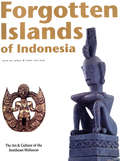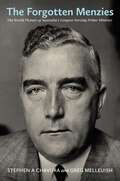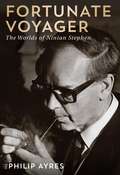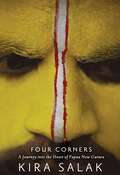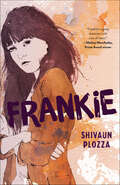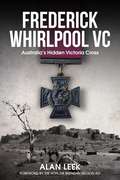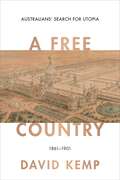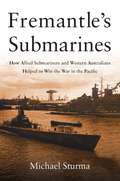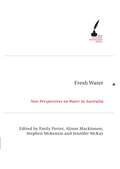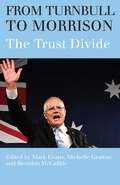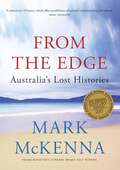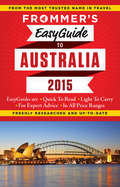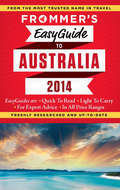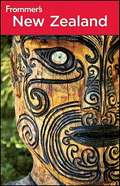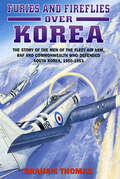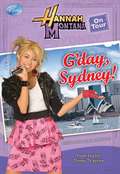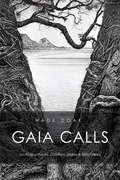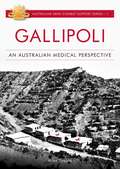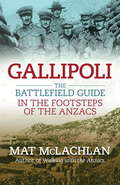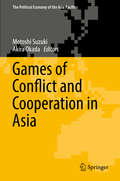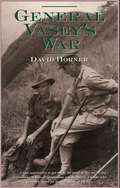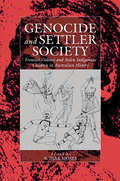- Table View
- List View
Forgotten Islands of Indonesia
by Joss Van Dijk Nico DejongeThis beautiful book contains over 170 unique photographs and pictures of one of the most interesting but least well known cultures in the Indonesian Archipelago.The traditional art of Maluku Tenggara, the Southeast Moluccas, is among the most sophisticated and expressive in the world. Simple tools were used to create masterpieces in wood, stone, textiles and precious metals, while the plaited work and earthenware of these islands are also of the very highest quality.the colonial period plunged the region into hopeless isolation. During the harsh rule of the Dutch many traditional woks of art, especially ancestor statues, were destroyed. Later, collectors stripped the islands of their masterpieces and the culture of Maluka Tenggara was forgotten.Forgotten Islands of Indonesia presents a unique survey of the finest examples of Southeast Moluccan art. This volume contains many photographs and descriptions which have never before been published. Set against the cultural background and supplemented by rare photographs taken in the field, the material culture of Maluku Tenggara, which is regarded as one of the most fascinating areas of Indonesia, is presented here comprehensively for the first time.
Forgotten Islands of Indonesia
by Joss Van Dijk Nico DejongeThis beautiful book contains over 170 unique photographs and pictures of one of the most interesting but least well known cultures in the Indonesian Archipelago.The traditional art of Maluku Tenggara, the Southeast Moluccas, is among the most sophisticated and expressive in the world. Simple tools were used to create masterpieces in wood, stone, textiles and precious metals, while the plaited work and earthenware of these islands are also of the very highest quality.the colonial period plunged the region into hopeless isolation. During the harsh rule of the Dutch many traditional woks of art, especially ancestor statues, were destroyed. Later, collectors stripped the islands of their masterpieces and the culture of Maluka Tenggara was forgotten.Forgotten Islands of Indonesia presents a unique survey of the finest examples of Southeast Moluccan art. This volume contains many photographs and descriptions which have never before been published. Set against the cultural background and supplemented by rare photographs taken in the field, the material culture of Maluku Tenggara, which is regarded as one of the most fascinating areas of Indonesia, is presented here comprehensively for the first time.
Forgotten Islands of Indonesia: The Art & Culture of the Southeast Moluccas
by Joss Van Dijk Nico DejongeThis beautiful book contains fascinating text and over 170 unique photographs of one of the most interesting but least well known cultures in the Indonesian Archipelago.The traditional art of Maluku Tenggara, the Southeast Moluccas, is among the most sophisticated and expressive in the world. Simple tools were used to create masterpieces in wood, stone, textiles and precious metals, while the plaited work and earthenware of these islands are also of the very highest quality.the colonial period plunged the region into hopeless isolation. During the harsh rule of the Dutch many traditional woks of art, especially ancestor statues, were destroyed. Later, collectors stripped the islands of their masterpieces and the culture of Maluka Tenggara was forgotten.Forgotten Islands of Indonesia presents a unique survey of the finest examples of Southeast Moluccan art. This volume contains many photographs and descriptions which have never before been published. Set against the cultural background and supplemented by rare photographs taken in the field, the material culture of Maluku Tenggara, which is regarded as one of the most fascinating areas of Indonesia, is presented here comprehensively for the first time.
Forgotten Menzies: The World Picture of Australia's Longest-Serving Prime Minister
by Stephen Chavura Greg MelleuishSir Robert Gordon Menzies was the founder of the Liberal Party of Australia. As well as being Australia's longest-serving prime minister, Menzies was the most thoughtful. Menzies' world picture was one where Britishness was the overriding normative principle, and in which cultural puritanism and philosophical idealism were pervasive. Unless we remember this cultural background of Menzies' thought then we will seriously misunderstand what he meant by the very project of liberalism. The Forgotten Menzies argues that Menzies' greatest aspiration was to protect the ideals of cultural puritanism Australia from two kinds of materialism: communism; and the mindset encouraged by affluence and technological progress. Central to Menzies' project of cultural and civilisational preservation was the university, an institution he spent much of his career extolling and expanding. The Forgotten Menzies makes an important contribution to the history of political thought and ideology in Australia, as to understanding the largely forgotten but rich intellectual origins of the Liberal Party.
Fortunate Voyager: The Worlds of Ninian Stephen
by Philip AyresOne life, many roles: soldier, brilliant barrister, High Court judge, Governor-General, Australian diplomat, mediator in Northern Ireland, member of the first war crimes tribunal since Nuremburg and Tokyo, head of UN and Commonwealth missions to crisis zones from Cambodia to Burma to Bangladesh, Sir Ninian Stephen is the recipient of five knighthoods and the most honoured Australian in history - and yet precisely because so much of his work was international it has rarely received the notice it deserves in his home country. In this, the first whole-of-life biography of the subject, Philip Ayres traces Stephen's early life in Scotland, England and around continental Europe, from Edinburgh and the Highlands to the spa towns of France and Germany, from the ski runs above Montreux to the Nuremberg Rally of 1938, including the details of his education at outstanding British and Swiss schools and his highly unorthodox "family" life as an only child with an absent father, the details of which, like so much here, have never previously been revealed. All this constitutes the unknown Ninian Stephen, and yet so much else in this book is new: the wartime Stephen, the barrister Stephen, and all the other aspects of his life traced in precise yet dramatic detail in a book whose momentum is generated through unique access to the full resources of the subject's personal papers.
Four Corners: A Journey into the Heart of Papua New Guinea
by Kira SalakFollowing the route taken by British explorer Ivan Champion in 1927, and amid breathtaking landscapes and wildlife, Salak traveled across this remote Pacific island-often called the last frontier of adventure travel-by dugout canoe and on foot. Along the way, she stayed in a village where cannibals m was still practiced behind the backs of the missionaries, met the leader of the OPM-the separatist guerrilla movement opposing the Indonesian occupation of Western New Guinea-and undertook an epic trek through the jungle. The New York Times said "Kira Salak is tough, a real-life Lara Croft. " And Edward Marriott, proclaimed Four Corners to be "A travel book that transcends the genre. It is, like all the best travel narratives, a resonant interior journey, and offers wisdom for our times. "
Frankie: A Novel
by Shivaun PlozzaShivaun Plozza’s debut novel, Frankie, is a genre-hopping, darkly funny novel about searching for the truth, finding yourself, and falling in loveFrankie Vega is angry. Just ask the guy whose nose she broke. Or the cop investigating the burglary she witnessed, or her cheating ex-boyfriend, or her aunt who's tired of giving second chances.When a kid shows up claiming to be Frankie's half brother, it opens the door to a past she doesn't want to remember. And when that kid goes missing, the only person willing to help is a boy with stupidly blue eyes, a criminal record, and secrets of his own.Frankie's search for the truth could change her life, or cost her everything.“Frankie's a great, gutsy character, full of heart.” —Printz Award winner Melina Marchetta, author of The Jellicoe Road and Saving Francesca
Frederick Whirlpool VC: Australia's Hidden Victoria Cross
by Alan LeekFrederick Whirlpool’s Victoria Cross is displayed near the entrance to the Hall of Valour at the Australian War Memorial, Canberra. It was the first VC pinned to an Australian uniform, yet almost nothing was known about its enigmatic recipient. Two acts of valour during the Indian Mutiny, won him the Victoria Cross, but 17 severe sword wounds ended his career. Arriving in Victoria in 1859, he became a volunteer rifleman and school teacher. His VC was presented in Melbourne in 1861. He was an applicant to join the Victoria Police, but a corrupt recruitment process and unsolicited political interference prevented it. Repulsed by fame, he fled and hid his cross from the world. Fragments of his story were known, but since 1895, they have been tainted by error, guesswork and in one recent British work, pure fantasy. This work solves an old mystery. It reveals his true identity and early life in Ireland before joining the East India Company Army. To understand his service, the Central Indian campaign under Sir Hugh Rose, is examined in some detail, something that has not been done before. The real horrors of that campaign are revealed to show their devastating impact on this sensitive man. Rich sources reveal his anguished story. Humphrey James&’ reasons for changing his identity and leaving his family forever, are unearthed. His life in Australia is revealed, showing his fall, firstly from policing and then teaching, in NSW. He undoubtedly struggled with his demons and believed that he was destined for eternal damnation. The passage of his Victoria Cross, after his death was unknown before it appeared on the market in 1927. Its movements and those of his Indian Mutiny medal with its Central India clasp, are now revealed&’ This fascinating story fills huge gaps in the narrative of this ordinary man, whose life is deserving of factual interpretation. It is a story of heroism, suffering and failure, but the forgotten man will triumph in its telling. His sad life ended as a recluse in 1899, and he was buried in an unmarked grave in Windsor. The only mourner who attended his funeral left a thread, which has allowed painstaking research to uncover the true story of this sad and purposefully enigmatic hero.
Free Country: Australians' Search for Utopia 1861–1901
by David KempA Free Country: Australians' Search for Utopia 1861-1901 tells how Australians, inspired by their new democracy, attempted to use their freedom to build a society without social and economic conflict. As the second book in a landmark five-volume Australian Liberalism series, A Free Country shows the successes and missteps in the attempt to establish the legal and moral foundations for a liberal society in Australia, examining the ideological battles of the period. The national politics of twentieth-century Australia had their roots during this time, as utopian dreams of 'social reconstruction' opposed liberal ideals of individual freedom, fostering the concept of 'class wars' and leading to the ongoing involvement of trade unions in politics. As emerging collective ideas of nationalism, empire, race and class challenged individual rights and threatened to seed domestic and international conflict, liberals succeeded in bringing the six colonies into one Australian nation founded on liberal principles, writing a constitution hailed as the most democratic in the world.
Fremantle's Submarines
by Michael SturmaFrom unpromising beginnings in March 1942, the submarine base at Fremantle became a vital part of the Allied offensive against Japan. Pushed back from the Philippines and the Netherlands East Indies, American submariners, accompanied by small numbers of Dutch, retreated to Fremantle on the remote west coast of Australia as a port of last resort. Far from their prospective patrol areas and their own supply lines, they had little reason to feel optimistic. Thanks largely to a welcoming civilian population, the morale of Allied submariners quickly improved, as did their effectiveness in fighting the enemy. The first arrival of American and Dutch submarines at Fremantle coincided with a period when Western Australians felt especially vulnerable. On 3 March Japanese Zero fighters bombed the towns of Wyndham and Broome, while the same day there were three Japanese submarine attacks on shipping off the Western Australian coast. With many locals convinced that a Japanese invasion was imminent, Allied submariners got an appreciative reception. While in relatively small numbers, submariners were widely perceived as an elite force not only within the navy, but more generally by those who admired their courage and commitment. Although the Australians had no submariners of their own, they supported the base through the mobilization of resources and labor. Joined by British submariners from 1944, Allied submarines made a total of 416 patrols from Fremantle during the course of the war, becoming the most active base in the Pacific after Pearl Harbor. Some of the most famous submarines of the Second World War - including USS Harder, USS Flasher and HMS Trenchant - operated out of Fremantle, and many of the submariners who sailed from that port made the ultimate sacrifice. The success of Fremantle’s submarines depended not only on personal heroism, but cooperation between allies. From disastrous beginnings, the Allies overcame inertia and national suspicions to become a much more effective fighting force than their enemies. The Australian government provided unstinting support, while Australian commandos shared the perils of many submarine patrols. Meanwhile cooperation between American, Dutch and British submariners pioneered joint naval operations in the Pacific. This book documents not only the courage of submarine crews and the multinational cooperation that developed between Allies, but integrates the experiences of submariners on shore with their operations at sea. The promise of leave in Australia made the hardships and perils of lengthy war patrols more bearable. News that a submarine was ending its patrol in Fremantle inevitably created an expectant excitement among the crew on board. The hospitality and sense of belonging fostered by Western Australians became legendary among Allied submariners and remains central to their wartime memories. Many of those memories focus on relationships with young women, frequently sealed permanently through marriages. Many submariners also remember fondly the high alcohol content of Australian beer. Most of all, however, they recall the generosity of those civilians who welcomed them into their homes and hearts. At the same time, visiting submariners helped fill the emotional void created in many Australian families by absent sons, brothers, fathers and husbands fighting overseas. In an atmosphere of wartime austerity and rationing, the submariners also proved generous in sharing scarce resources with the local population. From the standpoint of morale, Fremantle became one of the most successful military outposts of the Second World War.
Fresh Water: New Perspectives on Water in Australia
by Emily Potter Alison Mackinnon Stephen McKenzie Jennifer McKayIs water a resource or is it the source? Is it something to be consumed or does it have a life of its own? Recent histories of environmental misunderstanding and exploitation shadow our current regime of water management and use. While governments grapple with how to respond to widespread drought, the situation worsens. There is something amiss in current approaches to water. This timely collection of essays addresses the critical and contentious issue of water in Australia today and suggests a need to radically rethink our relationship with this fundamental substance. Contributors from a range of fields, from anthropology to visual arts, discuss the various ways in which we are caught up with water, and challenge us to take up the cultural transformations that underpin a sustainable ecological future.
From Turnbull to Morrison: Understanding the Trust Divide
by Mark Evans Michelle Grattan Brendan McCaffrieIs trust between the government and Australians broken? The country's leading institutions have been ranked among the least trusted in the world at a time when the economy has experienced twenty-seven years of economic growth. This has all happened since the 2016 federal election under the revolving prime ministerships of Malcolm Turnbull and Scott Morrison's first term. Turnbull was the fourth sitting prime minister in a decade to be removed by his own party. What role do these politically turbulent times play in this trust deficit? Scott Morrison has now been elected by the people. What does he and future prime ministers need to do to reboot civic belief in politics? How will history judge the contribution of the Turnbull and Morrison administrations? In From Turnbull to Morrison well-known political journalists including Michelle Grattan, George Megalogenis, Megan Davis, Virginia Haussegger, Mark Kenny and Katharine Murphy and leading academics such as Frank Bongiorno, Mark Evans, Susan Harris-Rimmer, Anne Tiernan, John Warhurst and George Williams examine the institutions, the issues and the leaders at the heart of this crisis. It is crucial reading for champions of liberal democracy. From Turnbull to Morrison: The Trust Divide is the thirteenth volume of Australia's longest running study of Australian Commonwealth Government, started in 1983.
From the Edge: Australia's Lost Histories
by Mark McKennaIn March 1797, five British sailors and 12 Bengali seamen struggled ashore after their longboat broke apart in a storm. Their fellow-survivors from the wreck of the Sydney Cove were stranded more than 500 kilometres southeast in Bass Strait. To rescue their mates and to save themselves the 19 men must walk 700 kilometres north to Sydney.That remarkable walk is a story of endurance but also of unexpected Aboriginal help.From the Edge: Australia's Lost Histories recounts four such extraordinary and largely forgotten stories: the walk of shipwreck survivors; the founding of a 'new Singapore' in western Arnhem Land in the 1840s; Australia's largest industrial development project nestled amongst outstanding Indigenous rock art in the Pilbara; and the ever-changing story of James Cook's time in Cooktown in 1770.This new telling of the central drama of Australian history ;the encounter between Aboriginal and non-Aboriginal Australians, may hold the key to understanding this land and its people.
Frommer's EasyGuide To Australia
by Lee MylneThe giant continent-nation of Australia, with its English-speaking population, is currently attracting a great number of visitors from North America and Great Britain. In this newly-revised, freshly-researched guide, author Lee Mylne, who is based in Brisbane (the third most populous city in Australia), deals with the cities and areas to which most tourists go. She has been an Australian travel journalist for nearly all her working life, and has traveled to every state and territory of Australia by every means of transport. She is also a life member and past president of the Australian Society of Travel Writers.
Frommer's EasyGuide to Australia 2014
by Lee MylneSelling for a lower price than any similar guidebook, and deliberately limited to a short 256 pages, this EasyGuide is an exercise in creating easily-absorbed travel information. It emphasizes the authentic experiences in each destination:the most important attractions, the classic method of approaching a particular destination; the best choices for accommodations and meals; the best ways to maximize the enjoyment of your stay. Because it is "quick to read, light to carry", it is called an "EasyGuide", and reflects Arthur Frommer's lifetime of experience in presenting clear and concise travel advice.
Frommer's New Zealand, 6th Edition
by Adrienne RewiWritten by a New Zealand resident, and full of personal insights and opinions, this guide takes you to one of the world's most exciting ecotourism destinations! It's much more complete and in-depth than its major competition. Whether you're dreaming of hiking along the Marlborough Sound, trout fishing in Lake Rotorua, driving the Milford Road, or feasting on sumptuous green-lipped mussels or succulent lamb, this detailed guide will help you plan the trip of a lifetime. You'll find the latest on nightlife in Auckland and Wellington and the best places to lay your head after an adventure-filled day, too. Frommer's New Zealand also features gorgeous color photos of the sights and experiences that await you.
Furies and Fireflies over Korea: The Story of the Men of the Fleet Air Arm, RAF and Commonwealth Who Defended South Korea, 1950–1953
by Graham A. ThomasThe historian and author details the exploits of British and Australian pilots during the Korean War. With the outbreak of the Korean War, the UN Security Council called on its members to act and 16 nations did, with Britain sending aircraft carriers such as HMS Truimph, from which piston-engined Sea Fury fighters and Fairey Firefly fighter-bombers operated. This is the story of the British and Australian Fleet Air Arm pilots and their missions over hostile territory, missions carried out with distinction and honor.
G'day, Sydney! (Hannah Montana on Tour #2)
by M. C. KingHannah Montana is off to the second city on her tour: Sydney. But when Jackson gets hit in the head with a boomerang, it starts an adventure faster than you can say, "Put some shrimp on the barbie." This all-new, original fiction series will showcase a different international city on Hannah's concert tour in each 80-page chapter book.
Gaia Calls
by Wade DoakWade Doak is one of the world's leading marine explorers. In Gaia Calls he takes his readers on a unforgettable journey. From his first discovery of the sunken treasure of the Elingamite, to life as a young man in the Solomon Islands living among the islanders, to years of dolphin research, diving adventures, and his discovery of interspecies communication. With patience, focus, and respect he shares his knowledge and love for the natural world, and leads his readers to a deeper understanding of the interconnectedness of all life. A fascinating and engaging document of a life well lived.
Gallipoli: An Australian Medical Perspective (Australian Combat Support #1)
by Michael TyquinTo be successful, a modern army needs logistical support to survive - to arm, feed, transport, and care for its soldiers. As history shows us the maintenance of health in any army , is a key factor in warfare. In many respects the Gallipoli campaign was a doomed undertaking. The seeds of ultimate defeat in December 1915 were the risks that attended a hugely ambitious, complex, and large-scale amphibious operation - the landings on well-defended shores on the Gallipoli peninsula, under cover of darkness. Communications at the time were primitive, while general staff officers had little understanding of their own army's medical assets or the needs of a large medical organisation. The Australian Army Medical Corps (AAMC) received aid from, and gave support to, all five forces at various times during 1915. Underlying the execution of the Dardanelles campaign were factors wholly outside the control of the Australian AMS. Undoubtedly tragic, and sometimes avoidable, errors were made at the highest level of command, with subsequent pressures on the AMS. An amphibious operation of this type and scale, however, was without parallel in modern military history, and mistakes were inevitable, as they are with any campaign of such complexity. Gallipoli: An Australian Medical Perspective explores these complexities and mistakes through the eyes of the infant Australian Army Medical Corps.
Gallipoli: The battlefield guide
by Mat MclachlanThe essential travel companion for anyone visiting Gallipoli.Each year, thousands of Australians visit Gallipoli to pay homage and see where their forebears fought, suffered and died. Anzac Cove, Quinn's Post, Lone Pine - the iconic places where our national legend was forged.In this essential and authoritative guide, practical information is combined with historical detail, alongside revealing and often heartrending quotes from the letters and diaries of the Anzacs themselves.- Detailed easy-to-follow plans for walking and driving tours across the main battlefields- Maps, photos and historical commentary to put the campaign in context- Everything you need to know where to go, where to stay and how to get there.Walk where the Anzacs walked, see where they fought and marvel at their courage.
Games of Conflict and Cooperation in Asia
by Motoshi Suzuki Akira OkadaThis edited volume is an outcome of the first major collaborative project between Japanese economists and political scientists, funded by the Japan Society for the Promotion of Science. The authors of the individual chapters show that Asian states play games of conflict and cooperation strategically by creating, changing, or destroying institutions. For them, conflict and cooperation are inseparable phenomena and are integral parts of states' strategic interactions under constraints. Through the establishment of appropriate institutions that coordinate states' actions, present conflict can be turned into stable cooperation in the future. No discernible difference exists in the extent of rationality between the East and the West, but substantial variations between regions or even within a region are found in institutions that are influenced by history and culture. Historical and cultural variations divide contemporary Asia, making regional institutional cooperation difficult and prompting some Asian states to use global or inter-regional arrangements in order to obtain benefits of cooperation. Qualifications are provided for this line of argument in the first chapter, which also discusses the affinity of international relations theory and game theory, with special attention to Japan and Asia. The following ten substantive chapters are developed based on the conceptual framework and, for integrity and coherence, are sub-grouped into four parts that correspond to major issues in international relations scholarship: (1) conflict management, (2) arms control, (3) trade, and (4) currency.
Gangland: The Great Escapes
by James Morton Susanna LobezSince the arrival of the First Fleet, thousands of prisoners have escaped from prison, police stations, courts, prison vans and hospitals—even dentists' chairs. They have driven, walked, pedalled, swum or sailed away from custody. Some have killed or been killed in the process; a few have gone overseas or escaped from foreign prisons, and a handful have remained at home, undetected. Gangland: The Great Escapes is filled with tall tales of crims—Ronald Ryan, Jockey Smith, Brenden Abbott, Julie Wright and Annie Davis, and many others—who have been recaptured in minutes and those who have stayed on the run.
General Vasey's War
by David HornerTo his troops he was 'Bloody George', a hard-bitten professional soldier, technically competent and tactically proficient. His brigade bore the brunt of the fighting in Greece. He commanded the entire Australian force in Crete in the battle against German airborne invaders. He directed the Australian advance from Kokoda and presided over the defeat of the Japanese in the savage battles of the beachheads. But there was more to Major-General George Vasey than his impressive record. Through the existence of a remarkable collection of letters to his wife, Jessie, we have a rare opportunity to get inside the mind of this successful commander. The picture that emerges is one that his closest comrades knew—one of compassion and humanity, a commander who genuinely cared for the well-being of his men. General Vasey's War analyses Vasey's military performance but it also allows us to share Vasey's private thoughts— his frustrations and triumphs, his hopes and cares. Through a unique insight into one man's war we are rewarded with a better understanding of the practice of warfare during those momentous years.
Genocide And Settler Society
by A. Dirk MosesColonial Genocide has been seen increasingly as a stepping-stone to the European genocides of the twentieth century, yet it remains an under-researched phenomenon. This volume reconstructs instances of Australian genocide and for the first time places them in a global context. Beginning with the arrival of the British in 1788 and extending to the 1960s, the authors identify the moments of radicalization and the escalation of British violence and ethnic engineering aimed at the Indigenous populations, while carefully distinguishing between local massacres, cultural genocide, and genocide itself. These essays reflect a growing concern with the nature of settler society in Australia and in particular with the fate of the tens of thousands of children who were forcibly taken away from their Aboriginal families by state agencies. Long considered a relatively peaceful settlement, Australian society contained many of the pathologies that led to the exterminatory and eugenic policies of twentieth century Europe.
